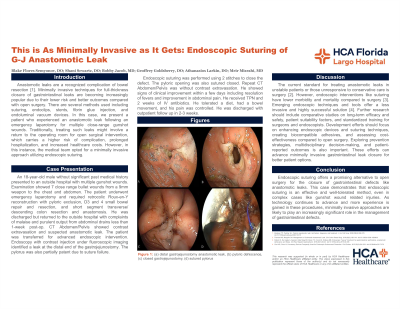Sunday Poster Session
Category: Interventional Endoscopy
P0886 - This Is as Minimally Invasive as It Gets: Endoscopic Suturing of G-J Anastomotic Leak
Sunday, October 22, 2023
3:30 PM - 7:00 PM PT
Location: Exhibit Hall

Has Audio

Blake Flores Semyonov, DO
HCA Largo Medical Center
Largo, FL
Presenting Author(s)
Blake Flores Semyonov, DO1, Shani Scwartz, DO2, Bobby Jacob, MD3, Geoffrey Goldsberry, DO1, Athanasios Larkin, DO4, Meir Mizrahi, MD5
1HCA Largo Medical Center, Largo, FL; 2FAU Boca Raton Regional, Boca Raton, FL; 3HCA Florida Largo Hospital, Largo, FL; 4HCA Largo Medical Center, Pinellas Park, FL; 5Largo Medical Center, Largo, FL
Introduction: Minimally invasive techniques for full-thickness closure of gastrointestinal defects are an active area of study due to their low morbidity and mortality compared with open surgery. There are several methods used including suturing, endoclips, stents, fibrin glue injection, and endoluminal vacuum devices. We present a case of an anastomotic leak related to emergency laparotomy for multiple close-range gunshot wounds repaired with endoscopic suturing.
Case Description/Methods: An 18-year-old male without significant past medical history presented to an outside hospital with multiple gunshot wounds. Examination showed 7 close range bullet wounds from a 9mm weapon to the chest and abdomen. The patient underwent emergency laparotomy and required retrocolic Roux-en-Y reconstruction with pyloric exclusion, D3 and 4 small bowel repair and resection, and short segment transverse/descending colon resection and anastomosis. He was discharged but returned to the outside hospital with complaints of malaise and purulent output from abdominal drains less than 1-week post-op. CT Abdomen/Pelvis with contrast showed contrast extravasation and suspected anastomotic leak. The patient was transferred for advanced endoscopic intervention. Endoscopy with contrast injection under fluoroscopic imaging identified a leak at the distal end of the gastrojejunostomy and the pylorus was also partially patent due to suture failure. Endoscopic suturing was performed using 2 stitches to close the defect. The pyloric opening was also sutured closed. Repeat CT Abdomen/Pelvis was without contrast extravasation. He received TPN and 2 weeks of IV antibiotics. He tolerated a diet, had a bowel movement, and his pain was controlled. He was discharged with outpatient follow up in 2-3 weeks.
Discussion: The current standard of care for treatment of anastomotic leaks in unstable patients or those who do not improve with conservative management such as bowel rest, nutritional support, and antibiotic therapy is surgical intervention. Emerging endoscopic techniques and tools such as endoscopic suturing, through the scope or over the scope clips, stents, and endoscopic vacuum therapy provide a less invasive and highly successful solution for gastrointestinal leaks. Compared to surgery, endoscopic intervention has lower morbidity and mortality. Further investigation should be conducted to analyze long term clinical success rates between endoscopic and laparoscopic repair of bowel leaks.
Disclosures:
Blake Flores Semyonov, DO1, Shani Scwartz, DO2, Bobby Jacob, MD3, Geoffrey Goldsberry, DO1, Athanasios Larkin, DO4, Meir Mizrahi, MD5. P0886 - This Is as Minimally Invasive as It Gets: Endoscopic Suturing of G-J Anastomotic Leak, ACG 2023 Annual Scientific Meeting Abstracts. Vancouver, BC, Canada: American College of Gastroenterology.
1HCA Largo Medical Center, Largo, FL; 2FAU Boca Raton Regional, Boca Raton, FL; 3HCA Florida Largo Hospital, Largo, FL; 4HCA Largo Medical Center, Pinellas Park, FL; 5Largo Medical Center, Largo, FL
Introduction: Minimally invasive techniques for full-thickness closure of gastrointestinal defects are an active area of study due to their low morbidity and mortality compared with open surgery. There are several methods used including suturing, endoclips, stents, fibrin glue injection, and endoluminal vacuum devices. We present a case of an anastomotic leak related to emergency laparotomy for multiple close-range gunshot wounds repaired with endoscopic suturing.
Case Description/Methods: An 18-year-old male without significant past medical history presented to an outside hospital with multiple gunshot wounds. Examination showed 7 close range bullet wounds from a 9mm weapon to the chest and abdomen. The patient underwent emergency laparotomy and required retrocolic Roux-en-Y reconstruction with pyloric exclusion, D3 and 4 small bowel repair and resection, and short segment transverse/descending colon resection and anastomosis. He was discharged but returned to the outside hospital with complaints of malaise and purulent output from abdominal drains less than 1-week post-op. CT Abdomen/Pelvis with contrast showed contrast extravasation and suspected anastomotic leak. The patient was transferred for advanced endoscopic intervention. Endoscopy with contrast injection under fluoroscopic imaging identified a leak at the distal end of the gastrojejunostomy and the pylorus was also partially patent due to suture failure. Endoscopic suturing was performed using 2 stitches to close the defect. The pyloric opening was also sutured closed. Repeat CT Abdomen/Pelvis was without contrast extravasation. He received TPN and 2 weeks of IV antibiotics. He tolerated a diet, had a bowel movement, and his pain was controlled. He was discharged with outpatient follow up in 2-3 weeks.
Discussion: The current standard of care for treatment of anastomotic leaks in unstable patients or those who do not improve with conservative management such as bowel rest, nutritional support, and antibiotic therapy is surgical intervention. Emerging endoscopic techniques and tools such as endoscopic suturing, through the scope or over the scope clips, stents, and endoscopic vacuum therapy provide a less invasive and highly successful solution for gastrointestinal leaks. Compared to surgery, endoscopic intervention has lower morbidity and mortality. Further investigation should be conducted to analyze long term clinical success rates between endoscopic and laparoscopic repair of bowel leaks.
Disclosures:
Blake Flores Semyonov indicated no relevant financial relationships.
Shani Scwartz indicated no relevant financial relationships.
Bobby Jacob indicated no relevant financial relationships.
Geoffrey Goldsberry indicated no relevant financial relationships.
Athanasios Larkin indicated no relevant financial relationships.
Meir Mizrahi: Boston Scientific – Consultant. COOK medical – Consultant. Fujifilm – Consultant. Medtronic – Consultant.
Blake Flores Semyonov, DO1, Shani Scwartz, DO2, Bobby Jacob, MD3, Geoffrey Goldsberry, DO1, Athanasios Larkin, DO4, Meir Mizrahi, MD5. P0886 - This Is as Minimally Invasive as It Gets: Endoscopic Suturing of G-J Anastomotic Leak, ACG 2023 Annual Scientific Meeting Abstracts. Vancouver, BC, Canada: American College of Gastroenterology.
